Module 2.2
Hartley Oscillator Practical Project
- After Studying this section, you should be able to:
- • Build a Hartley Oscillator from given instructions.
- • Test a Hartley Oscillator for correct operation.
- • Take measurements on a Hartley Oscillator.
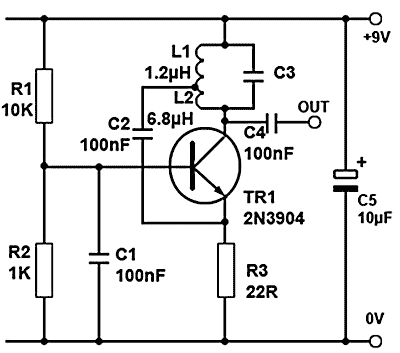
Fig. 2.2.1 Hartley Oscillator
Building The Hartley Oscillator
Build The Hartley Oscillator shown in Fig 2.2.1 using either breadboard (proto board) as shown in Fig. 2.2.2 or on strip board as shown in Fig. 2.2.3,. The frequency of the oscillator can be from around 560kHz to 1.7MHz depending on the value chosen for C3. Full constructional details to build the Hartley oscillator are given below. Test the oscillator by making the measurements described on the Hartley Oscillator Measurements sheet to verify the operation of the oscillator, using a multi-meter and oscilloscope. A really effective way to learn about Hartley oscillators!
This Hartley oscillator produces a sine wave output in excess of 12Vpp at an approximate frequency set by the value chosen for C3. Any of the C3 optional values shown below should give reliable oscillation.
The circuit will operate from a 9V battery, or a DC power supply of 9 to 12V. Supply current at 9V is around 20 to 30mA.
The circuit can be built on breadboard for testing purposes. It may be found that the value of R3 is fairly critical, producing either a large distorted waveform or intermittent low/no output. To find the best value for R3, it could be temporarily replaced by a 470 ohm variable resistor for experimentation to find the value that gives the best wave shape and reliable amplitude.
Components List
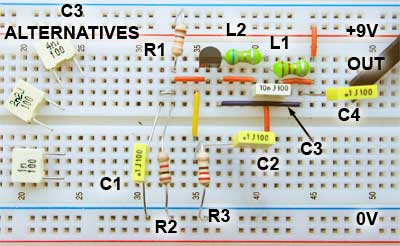
Fig. 2.2.2 Hartley Oscillator - Breadboard Version
| C3 Options | |
|---|---|
| Value | Frequency |
| 1nF | 1.7MHz |
| 2.2nF | 1.2MHz |
| 4.7nF | 821kHz |
| 10nF | 563kHz |
- TR1 = 2N3904
- C1, C2 & C4 = 100nF polyester film
- C3 = See C3 Options table.
- C5 = 10µF 25V electrolytic
- R1 = 10KΩ
- R2 = 1KΩ
- R3 = 22Ω (or 470Ω variable)
- L1 = 1.2µH
- L2 = 6.8µH
Stripboard Version
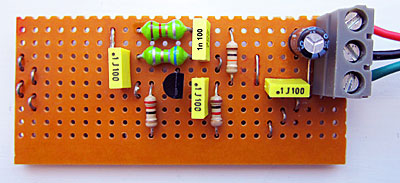
Fig. 2.2.3 Hartley Oscillator - Stripboard Version
Additional Components For Strip-board Version
- Strip board 9x25 holes
- 3 way connection block (Optional)
- 9V battery connector (Optional)
- Tinned copper wire (for links)
- Insulated flexible wire(for external connections)
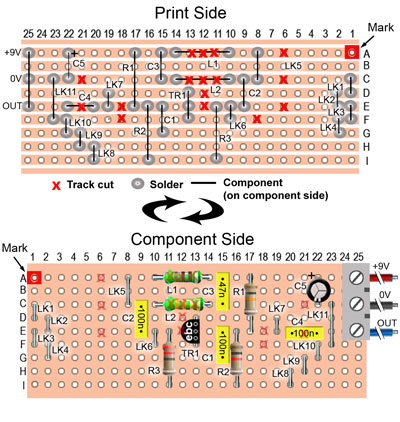
Fig. 2.2.4 Hartley Oscillator - Stripboard Layout
Construction on Stripboard
- On a piece of 9 x 25 hole strip-board, mark hole A1 to ensure that counting the strips and holes for placing track cuts and components always starts from the same point
- Mark the holes where track cuts are to be made. Double check their correct position before cutting.
- Make the track cuts.
- Solder the wire links in place.
- Solder the components in place in the following order.
- Resistors.
- Inductors.
- Polyester capacitors.
- Transistor (check for correct e b c positions before soldering).
- Electrolytic (check for correct polarity before soldering).
- Terminal Block.(This may be replaced by a 9V battery connector & and an output lead if preferred).
- Carefully check for any short circuits caused by solder bridging adjacent tracks, and for any poorly soldered joints.
- Connect up the power supply and connect an oscilloscope to the output.
- Adjust the 470Ω variable resistor (if used in place of R3) for best wave shape with reliable operation.
- Once the best position is found, remove the variable resistor and measure its value. It can then be repaced with a fixed resistor having a preferred value closest to the measured value.
Hartley Oscillator Measurements
Having built the Hartley oscillator, either on breadboard or strip-board, check that the circuit is oscillating satisfactorily by connecting the circuit to the 9V supply and. connecting an oscilloscope to the output terminals.
Voltage and Current Measurements
Ensure the oscillator is producing a sine wave output, and then measure and record the values listed in Tables 1 and 2.
| Table 1 | |
|---|---|
| Take the following measurements with the circuit oscillating in class C: | |
| The supply current | |
| The supply voltage | |
| TR1 collector voltage | |
| TR1 base voltage | |
| TR1 emitter voltage | |
| Table 2 | |
|---|---|
| Temporarily stop the oscillations by connecting a 0.47μF (non-polarised) capacitor across R3 and take the following measurements: | |
| The supply current | |
| TR1 collector voltage | |
| TR1 base voltage | |
| TR1 emitter voltage | |
| Table 3 | |
|---|---|
| The Peak to Peak Voltage | |
| DC Level of the Wave | |
| Periodic Time (T) of the Wave | |
| Frequency of the wave (1/T) | |
| Frequency of the wave calculated by ƒ= 1/ 2π√(LC) | |
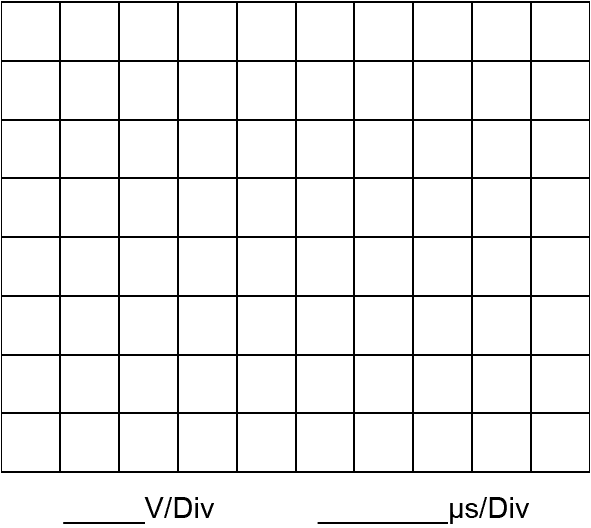

Waveform Measurements
Reconnect the oscilloscope to TR1 collector (not the circuit output terminal) and draw at least two cycles of the collector waveform on the grid.
Enter the volts/division and time/division settings of the CRO in the spaces provided.
From the waveform, calculate and record the values in Table 3.


